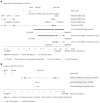Roles of the canonical myomiRs miR-1, -133 and -206 in cell development and disease
- PMID: 26322174
- PMCID: PMC4549760
- DOI: 10.4331/wjbc.v6.i3.162
Roles of the canonical myomiRs miR-1, -133 and -206 in cell development and disease
Abstract
MicroRNAs are small non-coding RNAs that participate in different biological processes, providing subtle combinational regulation of cellular pathways, often by regulating components of signalling pathways. Aberrant expression of miRNAs is an important factor in the development and progression of disease. The canonical myomiRs (miR-1, -133 and -206) are central to the development and health of mammalian skeletal and cardiac muscles, but new findings show they have regulatory roles in the development of other mammalian non-muscle tissues, including nerve, brain structures, adipose and some specialised immunological cells. Moreover, the deregulation of myomiR expression is associated with a variety of different cancers, where typically they have tumor suppressor functions, although examples of an oncogenic role illustrate their diverse function in different cell environments. This review examines the involvement of the related myomiRs at the crossroads between cell development/tissue regeneration/tissue inflammation responses, and cancer development.
Keywords: Cancer; Cell development; MiR-1; MiR-133a; MiR-133b; MiR-206; Muscle microRNAs.
Figures



Similar articles
-
Age-Related Exosomal and Endogenous Expression Patterns of miR-1, miR-133a, miR-133b, and miR-206 in Skeletal Muscles.Front Physiol. 2021 Nov 18;12:708278. doi: 10.3389/fphys.2021.708278. eCollection 2021. Front Physiol. 2021. PMID: 34867435 Free PMC article.
-
miR-133b, a particular member of myomiRs, coming into playing its unique pathological role in human cancer.Oncotarget. 2017 Jul 25;8(30):50193-50208. doi: 10.18632/oncotarget.16745. Oncotarget. 2017. PMID: 28422730 Free PMC article. Review.
-
Small molecule inhibitor of myogenic microRNAs leads to a discovery of miR-221/222-myoD-myomiRs regulatory pathway.Chem Biol. 2014 Oct 23;21(10):1265-1270. doi: 10.1016/j.chembiol.2014.06.011. Epub 2014 Sep 18. Chem Biol. 2014. PMID: 25242288
-
Muscle-specific microRNAs in skeletal muscle development.Dev Biol. 2016 Feb 1;410(1):1-13. doi: 10.1016/j.ydbio.2015.12.013. Epub 2015 Dec 19. Dev Biol. 2016. PMID: 26708096 Review.
-
Wnt/β-catenin signaling induces the myomiRs miR-133b and miR-206 to suppress Pax7 and induce the myogenic differentiation program.J Cell Biochem. 2019 Aug;120(8):12740-12751. doi: 10.1002/jcb.28542. Epub 2019 Apr 4. J Cell Biochem. 2019. PMID: 30945349
Cited by
-
The Clinical Significance of Changes in the Expression Levels of MicroRNA-1 and Inflammatory Factors in the Peripheral Blood of Children with Acute-Stage Asthma.Biomed Res Int. 2018 Jun 26;2018:7632487. doi: 10.1155/2018/7632487. eCollection 2018. Biomed Res Int. 2018. PMID: 30046607 Free PMC article.
-
miRNA-133b targets FGFR1 and presents multiple tumor suppressor activities in osteosarcoma.Cancer Cell Int. 2018 Dec 18;18:210. doi: 10.1186/s12935-018-0696-7. eCollection 2018. Cancer Cell Int. 2018. PMID: 30574019 Free PMC article.
-
Comprehensive Identification of Human Cell Type Chromatin Activity-Specific and Cell Type Expression-Specific MicroRNAs.Int J Mol Sci. 2022 Jun 30;23(13):7324. doi: 10.3390/ijms23137324. Int J Mol Sci. 2022. PMID: 35806329 Free PMC article.
-
Global MicroRNA Profiling Uncovers miR-206 as a Negative Regulator of Hematopoietic Commitment in Human Pluripotent Stem Cells.Int J Mol Sci. 2019 Apr 8;20(7):1737. doi: 10.3390/ijms20071737. Int J Mol Sci. 2019. PMID: 30965622 Free PMC article.
-
Exercise-Induced Circulating microRNAs: Potential Key Factors in the Control of Breast Cancer.Front Physiol. 2022 Jun 16;13:800094. doi: 10.3389/fphys.2022.800094. eCollection 2022. Front Physiol. 2022. PMID: 35784874 Free PMC article.
References
Publication types
Grants and funding
LinkOut - more resources
Full Text Sources
Other Literature Sources

